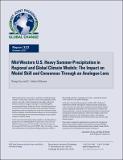| dc.contributor.author | Gao, Xiang | |
| dc.contributor.author | Schlosser, C. Adam | |
| dc.date.accessioned | 2019-07-01T20:49:52Z | |
| dc.date.available | 2019-07-01T20:49:52Z | |
| dc.date.issued | 2017-10 | |
| dc.identifier.uri | https://hdl.handle.net/1721.1/121469 | |
| dc.description.abstract | Regional climate models (RCMs) in general can simulate the characteristics of heavy/extreme precipitation more accurately than general circulation models (GCMs) as a result of more realistic representation of topography and mesoscale processes. An analogue method of statistical downscaling, which identifies the resolved large-scale atmospheric conditions associated with heavy precipitation, is also found to produce more accurate and precise heavy precipitation frequency across a range of GCMs in the Coupled Model Intercomparison Project Phase 5 (CMIP5) than their model-simulated precipitation alone. In this study, we examine the performances of the analogue method versus direct simulation, when applied to the RCM simulations from the North American Regional Climate Change Assessment Program (NARCCAP) and GCM simulations from CMIP5, in detecting present-day and future changes in summer (JJA) heavy precipitation over the Midwestern United States. We find the performances of two analogue schemes are comparable to those of MERRA-2 assimilated and its bias-corrected precipitation in characterizing the occurrence and interannual variations of observed heavy precipitation events, all significantly improving upon MERRA assimilated precipitation. For the late twentieth-century heavy precipitation frequency, RCM precipitation improves upon the corresponding driving GCM from CMIP5 with greater accuracy yet comparable inter-model discrepancies, while both RCM- and GCM-based analogue results outperform their model-simulated precipitation counterparts in terms of accuracy and model consensus. For the projected trends in heavy precipitation frequency through the mid twenty-first century, the analogue method also manifests its superiority to direct simulation with reduced intermodel disparities, while the RCM-based analogue and its simulated precipitation do not demonstrate a salient improvement (in model consensus) over the GCM-based assessment. However, a number of caveats preclude any overall judgement, and further work—over any region of interest—should include a larger sample of GCMs and RCMs as well as ensemble simulations to comprehensively account for modeled internal variability. | en_US |
| dc.description.sponsorship | This work was funded by MacroSystems Biology Program Grant (NSF-AES EF#1137306) from National Science Foundation and An Integrated Framework for Climate Change Assessment (DE-FG02-94ER61937) from the Department of Energy. We acknowledge the modeling groups, the Program for Climate Model Diagnosis and Intercomparison (PCMDI), and the WCRP’s Working Group on Coupled Modeling (WGCM) for their roles in making available the WCRP CMIP5 multimodel dataset. We also thank the North American Regional Climate Change Assessment Program (NARCCAP) for providing the data used in this paper, the NOAA Climate Prediction Center for the global gridded precipitation observations, and the NASA Global Modeling and Assimilation Office for the MERRA-2 Reanalysis data. | en_US |
| dc.language.iso | en_US | en_US |
| dc.publisher | MIT Joint Program on the Science and Policy of Global Change | en_US |
| dc.relation.ispartofseries | MIT Joint Program Report Series;322 | |
| dc.title | Mid-Western U.S. Heavy Summer-Precipitation in Regional and Global Climate Models: The Impact on Model Skill and Consensus Through an Analogue Lens | en_US |
| dc.type | Working Paper | en_US |
| dc.identifier.citation | Report 322 | en_US |
